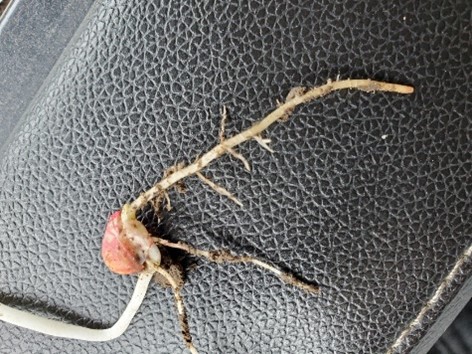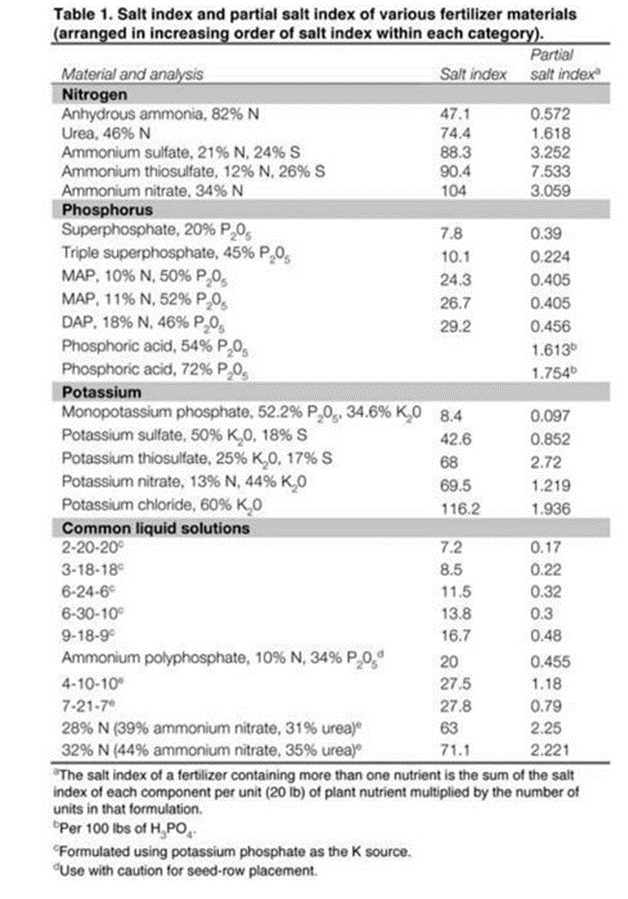 Figure 1 Burnt radicle due to salt injury. Photo from UNL Extension
Figure 1 Burnt radicle due to salt injury. Photo from UNL Extension
- Starter fertilizers are used to increase initial seedling growth and establishment.
- Fertilizers with high salt indices may cause desiccation or death of seedlings if applied inappropriately
- Ammonia burn may also injure seedlings if applied incorrectly.
With planting soon to start, you may have questions about starter fertilizer applications for both corn and soybeans. Starter fertilizer is defined as small amounts of nutrients placed in a concentrated zone near the seeds at planting. The goal of a starter fertilizer is to provide easily accessible nutrients for crop growth during the initial phases of growth, thereby improving establishment. This article will review factors to consider when making in furrow or 2 x 2 starter fertilizer applications.
Definition of salt index
Fertilizer salt index is a measure of the salt concentration induced in a soil solution. It does not predict the exact amount of fertilizer material / formulation that could produce crop injury under specific soil conditions, but it does enable comparisons of formulations for their potential salt effects. The salt index is a numeric ratio of the increase in osmotic pressure produced by a selected fertilizer product compared to that produced by the same weight of sodium nitrate (NaNO3), where sodium nitrate is assigned a relative value of 100. The higher the salt index value, the greater potential for salt related injury to the crop. Examples of different fertilizer materials and their salt index values can be found in Table 1.

Starter fertilizer related injury risks
Salt injury can occur when the salt is near the germinating seed or to growing plant tissue. The presence of the salt creates an osmotic imbalance in which water flows from regions of lower relative salt concentration in the plant tissue to regions of higher relative salt concentration where the fertilizer is in the soil. This loss of water from the plant tissue causes desiccation injury, often referred to as fertilizer burn.
An additional potential crop injury risk that can occur is free ammonia burn. This ammonia burn should not be confused with anhydrous ammonia burn. Fertilizer sources such as urea, UAN, ammonium thiosulfate, and DAP can liberate ammonia and burn seed or plant tissue. Use of these fertilizer sources on the seed or in a 2” x 2” placement results in release of ammonia when these sources are applied to soils. Use of these sources of nutrients on the seed should be avoided, while the use of a 2” x 2” configuration should be limited to rates reflecting only early season crop needs. Failure to follow these guidelines may result in significant crop injury. Other sources of fertilizer such as MAP, ammonium sulfate and ammonium nitrate do not release ammonia as easily and are of lesser concern, but not completely absolved of this type of injury.
As a rule of thumb, you should not apply more than 10 lbs/acre of N + K2O products alone or in combination as a seed furrow application. In addition, products with salt indices greater than 20 should not be used. While a 2” x 2” planter application allows for higher rates of application beyond early season crop needs, there are limitations on the amount of fertilizer that can be banded. These limitations are dependent on based on soil texture, CEC, and soil pH. Coarse soil textures (sandy soils) have greater pore space, allowing increased movement of concentrated liquified forms and liberated ammonia away from the band. Lower CEC soils (CEC ≤ 12) have fewer exchange sites to which ammonium and potassium ions can attach, leaving them mobile in the soil.
Regardless of the soil pH prior to application, ammonia volatilization and plant injury can occur under higher rates of free ammonia liberating fertilizers such as urea, ATS, UAN, and DAP. Open pore spaces can provide a pathway to the young roots or seed to gases and salt solutions. Any plant roots that grow toward concentrated bands of fertilizer can become burned, which can affect the root’s ability to take up nutrients. If cool wet conditions exist, prolonged contact with fertilizer bands can result in salt injury or ammonia burn.
Crop injury from salt injury and /or liberation of free ammonia are of little concern under normal rates of fertilizer except under these conditions:
- In-furrow, pop-up, on-the-seed and 2” x 2” placement of fertilizer
- High salt index fertilizers are applied.
- Higher than early season crop needs of fertilizer are applied.
- Soils are dry, preventing normal dilution of product through the soil and allowing high concentrations to remain near seed.
- Weather conditions are hot and dry.
- Soil pH is >6.8 resulting in liberation of ammonia. The higher the rate applied, the greater the risk.
- Urea, ammonium thiosulfate or DAP are used as a high percentage of total analysis applied as a 2”x2” band. DO NOT APPLY THESE SOURCES IN-FURROW.
- Maladjusted or ill-maintained starter equipment that results in placement of fertilizer closer than 2”
Using certain micronutrients with starter fertilizers can negatively impact crop establishment. For example, applying boron directly on the seed can significantly decrease germination. With all other secondary nutrients and micronutrients, add small quantities to the mix to ensure that no antagonisms occur. Antagonisms can be related to the formation of unwanted compounds or competition with macronutrients for plant uptake.
Whether using an in-furrow or a 2” x 2” starter application, moderation of the rate applied goes a long way in mitigating the risk of injury to the seed or plant.
For assistance on starter fertilizer rates and the potential adverse effects on the crop as an in-furrow or a 2” x 2” application, contact your FS Crop Specialist.
References:
Understanding Salt Index of Fertilizers by Carrie A.M. Laboski of the University of Wisconsin-Madison. NebGuide G316 from University of Nebraska Extension.
Starter phosphorous fertilizer and additives in North Carolina Soils: Use, placement, and plant response